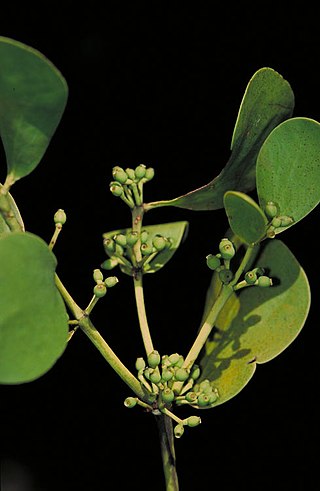Top Qs
Timeline
Chat
Perspective
Cecarria
Genus of mistletoes From Wikipedia, the free encyclopedia
Remove ads
Cecarria is a monotypic genus in the family Loranthaceae. The sole species is Cecarria obtusifolia, a hemiparasitic aerial shrub.[1]
Remove ads
Description
Cecarria obtusifolia is an aerial, stem-parasitic shrub, and like species in the genus Muellerina, it has epicortical runners.[3] It is glabrous throughout.[4] The obovate or broadly obovate[3] leaves are opposite, curvinerved, and rounded at the apex.[3] The leaf blades are 30–55 mm long and 20–45 mm wide, and attenuate into an obscure petiole 2–6 mm long.[5] The inflorescence is axillary, with and a two-flowered umbel or a four-flowered raceme or spike; there are nearly orbicular bracts[5] beneath each flower.[3] The flower has six free petals. The stamens are nearly equal, and the anthers are dorsifixed and versatile,[3] having a short sterile tip with the free part of the filament about 2 mm long.[5]
The peduncle is 6–9 mm long and up to 20 mm when the inflorescence is a raceme. The flowers are sessile or on pedicels up to 3 mm long. The calyx is entire and 0.5–1 mm long. The ivory-white corolla in mature bud is 10–14 mm long and slightly club-shaped. The fruit is almost spherical and about 8 mm long.[5]
Remove ads
Distribution and habitat
Cecarria obtusifolia occurs in the Philippines, New Guinea, the Solomon Islands, and in Cape York Peninsula, Queensland, Australia,[3] and also in the Lesser Sunda Islands and Bougainville (New Guinea).[6] The genus is thought to be a relictual Gondwanan entity.[3]
In Australia it occurs in the McIlwraith Range area in Queensland, growing in rainforest. Recorded hosts include plants in the genera: Calophyllum, Casuarina,[7] and Syzygium, and Xanthostemon.[5][7]
Remove ads
Taxonomy
The species was first described by Elmer Drew Merrill as Phrygilanthus obtusifolius in 1906.[5][4] In 1973, Bryan Barlow redescribed it, assigning it to the new genus, Cecarria, and the name thus became C. obtusifolia.[1][2] The current accepted description is that of Barlow in 1984.[1][8]
The genus Cecarria is named for Cedric Errol Carr (1892–1936).[3] The leaves, which are blunt and rounded at the apex (tip), gave rise to the latin-derived name, obtusifolia, meaning "obtuse-leaved".[9]
Conservation
It is considered to be "Not Threatened" (NT) in Queensland under the Nature Conservation Act 1992 of Queensland.[10]
References
External links
Wikiwand - on
Seamless Wikipedia browsing. On steroids.
Remove ads


